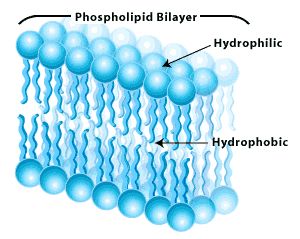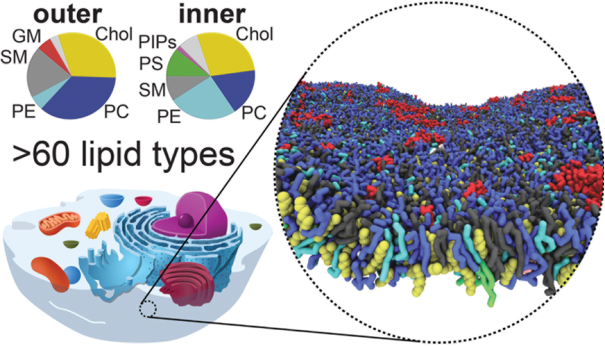Breakthrough in cell membrane research
Scientists at the University of Groningen have created the most complex simulation ever of a small section of cell membrane. Instead of a cell membrane consisting of four or five components, as is usual, they simulated a realistic membrane with no fewer than 63 types of lipids, the fatty molecules that comprise the building blocks of such membranes. ‘This will result in an explosion of new research’, says Professor of Molecular Dynamics Siewert-Jan Marrink. The results were published this week on the website of the top chemistry journal JACS.

‘This research provides the first insight into how lipids behave in the complex environment of a cell membrane’, says Marrink. The cell membrane, the fatty skin that surrounds all our cells, is essential for many of the cell’s functions. Therefore, it is important to know how that membrane behaves at a molecular level.
The cell membrane consists of a double layer of lipids, with their hydrophilic (water-loving) head on the outside and their fatty tails on the inside. Over the past few years it has become clear that a membrane has numerous different types of lipids, which behave differently and are therefore likely to have different functions. ‘But experimental techniques are unable to look at these lipids in sufficient detail to establish their role’, according to Marrink. ‘This can, however, be achieved using simulations’.
Martini
The characteristics of the various lipids are described in detail for the simulations. ‘This can be done at an atomic level, but it takes a lot of computing power. Therefore, we use a coarse-grained description in which we describe four or five atoms as a unit.’ This takes place in a computer model named Martini, which has been developed by Marrink and his group over the past decade. His research group is part of the Groningen Biomolecular Sciences and Biotechnology Institute and the Zernike Institute for Advanced Materials at the University of Groningen.
‘We have described several hundreds of lipids in Martini, and for this simulation we used the 63 lipids that are most frequently found in a typical mammalian cell membrane’, says Marrink. A simulation package subsequently works out the interactions between all these lipids, in this case a total of more than twenty thousand.
Islands
In the publication, which is currently online in JACS and which will appear in print within a month or two, the Groningen researchers answer two questions that have kept biologists busy for a long time. ‘Cell membranes consist of approximately thirty percent cholesterol, which determines the fluidity of the membrane. An important question is how cholesterol is distributed between the inner and the outer layer.’ The simulation demonstrated that the outer half of the membrane contained 54 percent of all cholesterol and the inner half 46 percent.
‘Furthermore, we could demonstrate that certain fatty acids are attracted to each other. They form domains, islands with a specific composition in the cell membrane; however, they exist for several microseconds only.’ Marrink observed for example large groups of gangliosides, a type of lipid that is used by flu viruses, and other viruses, to infect cells.
There has been speculation about the existence of these types of islands for years, but they have now been shown to exist for the first time. They may be important for the action of proteins that are present in the membrane. ‘The next step for us will be to add proteins to our simulations as well. We are already working on that.’
Explosion
Other researchers can now start using the realistic cell membrane described in this article by Marrink and his group. ‘I think this will lead to an explosion of new research’, he predicts. The step from a maximum of five to over sixty lipids in a simulated membrane is a great breakthrough. ‘We have already received many enthusiastic comments from colleagues since the article appeared online.’
For example, it is now possible to alter the composition of the simulated membranes to see how that influences the characteristics. ‘And experimental researchers can in turn use these simulations to interpret their results. Our work has led to fundamental new knowledge that can be used in numerous different fields.’

More information
- Prof. Siewert-Jan Marrink is Professor of Molecular Dynamics and Head of the Molecular Dynamics Department at the Groningen Biomolecular Sciences and Biotechnology Institute of the University of Groningen.
- Reference: Lipid Organization of the Plasma Membrane . Helgi I. Ingólfsson, Manuel N. Melo, Floris J. van Eerden, Clément Arnarez, Cesar A. Lopez, Tsjerk A. Wassenaar, Xavier Periole, Alex H. de Vries, D. Peter Tieleman, and Siewert J. Marrink, Journal of the American Chemical Society, DOI: 10.1021/ja507832e
More news
-
02 December 2025
Student Menna Zahran wins Unilever Research Prize
-
27 November 2025
Aeroplane spotting using a radio telescope
-
26 November 2025
Why are shiny colours rare yet widespread in nature?
